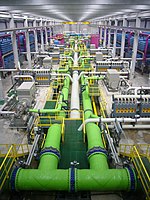
Photo from wikipedia
Abstract Electrodialysis-related technologies keep spreading in multiple fields, among which water desalination still plays a major role. A new technology that has not yet been thoroughly investigated is capacitive electrodialysis… Click to show full abstract
Abstract Electrodialysis-related technologies keep spreading in multiple fields, among which water desalination still plays a major role. A new technology that has not yet been thoroughly investigated is capacitive electrodialysis (CED), which couples the standard ED with capacitive electrodes. CED has a number of advantages such as removal of toxic products and system simplification. Little mention is made of this technology in the literature and, to the best of our knowledge, no modelling works have ever been presented. In this work, the CED process has been studied through experiments and modelling. A CED model is presented for the first time. With a simple calibration based on macroscopic membrane properties and the characterisation of electrode behaviour, the model is able to simulate the dynamics of simple as well as more complex layouts. An original experimental characterisation of electrodes is presented, showing how the collected data can be implemented into the model. After a successful validation with experimental data, dynamic simulations of a single pass CED unit have been performed with the aim of assessing the effect of different capacitive electrode properties on process performance. Results show how the impact of these properties is different depending on the number of cell pairs.
Journal Title: Desalination
Year Published: 2020
Link to full text (if available)
Share on Social Media: Sign Up to like & get
recommendations!